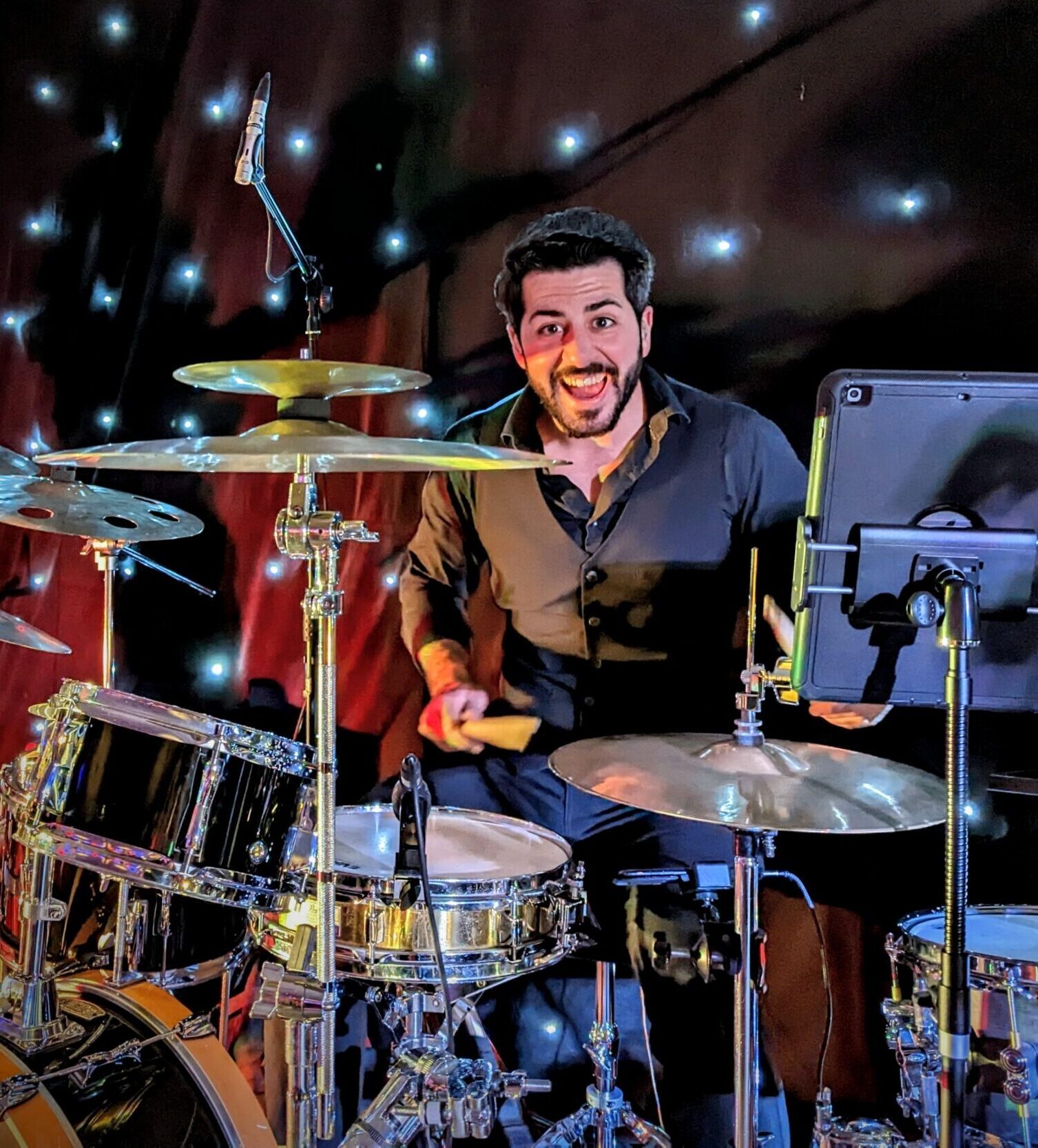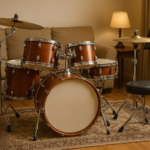How to Practice Drums – Early Stages
You just picked up a pair of drumsticks. Came in for a lesson with me and I gave you some guidelines. However, you got home and forgot everything I said about how to practice and what you needed to do. Despair not, because happens all the time and me from the past is writing this for you. You’re very welcome. Don’t worry, this reminder is free of charge.
Before I tell you exactly what to do remember this: You are in the very early stages. Everything is new for you. You don’t even know what you don’t know. On the other side of this is me. I have been playing for many years, very likely more than you’ve been alive. I am by no means done with my own journey, but I am far enough into it that I may have forgotten some aspects of how it feels to be new at drums. And even if I managed to retain the memory of the awkard feelings from my early days, my story with this instrument is likely different to yours so I may need help understanding your specific needs.
This is to say: ASK questions, tell me how you feel, tell me what you think about what we are doing. This gives me a window into who you are and how you see the world, which is immensely helpful when crafting the lessons to fit to your needs and desires. Remember, this is your journey, I am just an advisor.
First step is to divide your time into two big buckets.
- Deliberate Practice
- Deliberate Play
I learnt these terms from Anders Ericsson, who distilled his 30 year career in the development of Expertise and Peak Performance into the book Peak: Secrets from the New Science of Expertise. Practice is very focused, goal oriented and structured. Playing is free, creative and the only goal is to have fun. Practice will be tedious at times, but sticking with it will ensure progress on the drum kit (expanding your ability to play and have fun later), will build your character and develop your ability to trust the process of learning. Dedicating some time to play will give you the chance to enjoy your progress and fall in love with the instrument. Do not ignore one at the expense of the other. They are both massively important. No one is perfect at this, but try your best to keep playing and practising separate!
The lessons with me will be extremely skewed towards practice. You know how to play, you are a mammal. You share play circuits deep in your brain with all sorts of creatures, it is a very old system and you don’t need me to teach you how playing works. The only question in your head should be am I having fun?, if the answer is yes you are doing it right. However, practice is a much more difficult skill to learn so I will make good use of our time together and focus on that as I think it’s more effective this way (maybe I’ll change my mind at some point, I’ll keep you posted!). When you are on your own, though, don’t forget to play. Ebb and flow with your own rhythms over time: sometimes prioritise playing, other times prioritise practice.
To start with try this method: 2/3 practice, 1/3 play. If you have 30m, you will do 20m practise, 10 minutes playing. If you have 1h, 40 and 20 respectively. If 45m: 30m and 15m. You don’t have to be precise to the second, it is just a rough guideline.
Practice first, then play. From personal experience and student reports I find that playing songs or messing around randomly over the drums too early into the practice session scatters my thoughts and makes it hard to focus intensively later, which diminishes the quality of the practice. Prioritise learning early and only afterwards play to your heart’s contempt knowing that you did something difficult and have earned your right to let go and have some fun guilt-free.
When practising something new start by playing it extremely slowly, without a metronome.
And I mean, EXTREMELY SLOWLY.
One.
Note.
At.
A.
Time.
You are working on the choreography required to perform, but you are not performing yet. It takes time, discipline and focus. This step is all about sequencing the movements in as clean a way as possible, as to do it incorrectly will hinder your progress later on.
Think of yourself like an F1 car: Untold millions of pounds are invested each year to shave a millisecond off the lap time because they know that inefficiencies compound at high speeds. You will have the same problem just to play the most basic stuff at normal tempos. I know it because we all go through this. Normal dance tempos are quite fast, so much so that mean you will need to play faster than you can think, so you need to teach your body how to do things properly in the practice room and then get out of its way when it is time to perform.
When I want to play something it feels like I am releasing a wrecking ball. I don’t think about each note, but the shape of what I want to play and my body does it. Just like when you grasp a glass of water and you don’t think about the placement of your fingers or the angle of your elbow joint.
Let me drive this point further: a song written for an audience to dance to will be somewhere around 120 bpm (beats per minute). This means there are 2 beats per second. Human reaction time to simple stimuli is 1 second. If you try to think before playing you will be 2 beats late every time. The only way around this is teaching your body what to do and letting it take over. Your inner voice should be like a coach of a football team, observing the game and shouting from the sidelines what to do next, but unable to actually perform.
Make sure you are moving smoothly before moving on the next step. As the navy seals say (allegedly): Slow is Smooth and Smooth is Fast.
Next, start playing it in time as if the notes are not a sequence of individual notes, but they are now a meaningful grouping. If it is a groove, they should feel like a pulse is starting to emerge, all the notes cohere into something different than the sum of its parts. This is called a Gestalt.
However, do not loop it yet. When playing drums most of what you do is repeat, repeat, repeat. Then change. Then repeat, repeat, repeat. You should be able to loop everything you learn many times at a variety of tempos and circumstances before thinking you can actually play it when it matters most. To get to that point, you need to be comfortable playing it once, many times. Think of it like a body builder: they organise their workouts into exercises, sets (with rests in between) and repetitions. At this point in time, you are going to do a particular exercise, for 4 sets of 1 rep. If you were a body builder you will grab the weights, lift them once, leave them on the floor and take a break. For you one set will look like this (Your break is one breath long):
|:Inhale, exhale, play, stop:|x4
Only when you manage to play it like this without mistakes, move forward and add another rep.
|:Inhale, exhale, (play)x2, stop:|x4
Then
|:Inhale, exhale, (play)x3, stop:|x4
And so on. 4 sets of 4 reps is a good rule as to when to increase the tempo and go through the process all over again.
Now, to the details on what to actually do. Your first practice session could look like this:
Deliberate practice:
- Grooves
- 1 Bar 8th note linear grooves (10m)
- Goal: 4 times each without stopping, rushing or dragging
- 1 Bar 8th note linear grooves (10m)
- Fills
- Fills 4 notes per drum (5m)
- Goal: 4 times each
- Fills 4 notes per drum (5m)
- Song
- Play believer – imagine dragons without going out of time all the way to the chorus 3 times (5m)
Deliberate Play:
- Play the drums freely, randomly or to a song I enjoy.
- Goal: Have as much fun as possible, play things I like, enjoy myself come up with new stuff creatively without care or consequence.
This is enough for now. As the lessons progress add things, substitute and optimise. Also, your practice time should not be focused only on the material I provide, you can add whatever you think it’s relevant to your journey. Your practice schedule will change and evolve, you’ll learn about yourself and tweak as you go.
As the XX century philosopher Bruce Lee once said:
“Absorb what is useful. Discard what is not. Add what is uniquely your own.”
Even more, I’d love for you to come into the lesson and say: “Oscar, I tried your suggestions, some of it worked but I found that other bits didn’t so I’m going to try this other thing next time”. That will fill me with joy as it will start a conversation about what works for you. I am still learning about what works for me, so you may be able to teach me a thing or two if you pay attention to how you feel when you practise, what results you get and share them with me.
I hope that this is helpful for you. I will see you on our next lesson.If you have any questions, comments, queries, concerns, requests, complaints, critiques, quandaries, curiosities, quibbles, conundrums, considerations or closing thoughts don’t hesitate to ask me.
In the meantime, may the groove be with you.
O.

